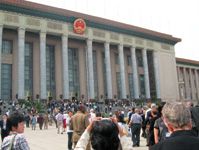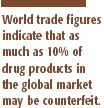Combating counterfeit drugs an international problem
The International Pharmaceutical Federation addressed progress in identifying and dealing with issues related to ersatz (or replacement) drug products.

This year's FIP meeting, held in Beijing, addressed the progress in identifying and dealing with issues related to ersatz (or replacement) drug products. During a joint session of the FIP Board of Pharmaceutical Practice and the FIP Board of Pharmaceutical Sciences, representatives from the United States, the United Kingdom, China, and India presented updates on the current status of the problem.
World trade figures indicate that as much as 10% of drug products in the global market may be counterfeit. Statistics indicate that India may have up to 35% of its products in question. However, the Indian government estimates that from 1995 to 2003, the extent of the problem varied between 0.24% and 0.47% for counterfeit and from 8.9% to 10.64% for substandard drugs.

A study was undertaken in 2003 to determine the relative prevalence by state/region, approximate the volume and percent through retail outlets, and ascertain the prevalence in various therapeutic segments and cost ranges. It classed locations by degree of the area's regulatory strength for the problem. A representative list of therapeutic categories and price variables was used to determine the candidate drugs. "Mystery customers" were used to gather the samples, guides for physical verification of samples were designed, and approved drug-testing laboratories were employed.
Sheth told the audience that the results of the survey may have been skewed to some degree by the methods used in sample gathering. The study results showed an average extent of counterfeit drugs to be 3.1% based on physical inspection, and almost the same degree was found in the areas regardless of strong or weak regulation. Lab values indicated only 0.3% did not meet pharmaceutical standards. High on the list of questionable products were those for treatment of TB and certain antibiotics. The study did not address products to be exported.
Big business
Reporting from the United States, Michael Anisfeld, pharmacy consultant, Globepharm, Deerfield, Ill., said drug counterfeiting is big business. He quoted a figure of 8%-15% of global sales as counterfeit, with no continent immune. In a global market worth $620 billion, those figures would project to $50-$93 billion. The Partnership for Safe Medicines projects $75 billion worth of counterfeit drugs by 2010. While developing countries find counterfeits in drugs of need such as antimalarials, antibiotics, and anti-HIV/AIDS drugs, the developed world sees more counterfeits in lifestyle drugs or the most costly products.
Noting the proliferation of Internet suppliers, Anisfeld said that approximately 70% of these products may be of questionable provenence. He reminded attendees that more than 300 people had died in Panama in 2006 due to counterfeiting of glycerin by the substitution of diethylene glycol from China. He tracked the movement of the product through wholesalers and brokers and decried the lack of an auditing trail and the absence of sampling and analysis of the product before use.
Counterfeit packaging is a major problem, along with counterfeit holograms and counterfeit documentation.
How PBMs Impede Pharmacists’ Ability to Perform Clinical Services | APhA 2025
March 31st 2025Antonio Ciaccia, President of 3 Axis Advisors, led a discussion on pharmacy benefit manager reform and how the inability to pass legislation has led to increased financial hardships in community pharmacy.